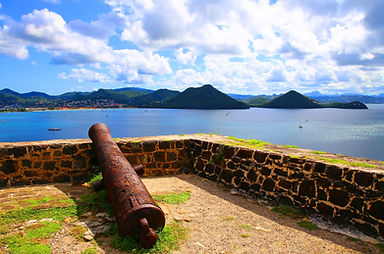

Welcome to St. Lucia
St. Lucia is nestled between the Caribbean Sea and the Atlantic Ocean and is 27 miles long and 14 miles wide. The tropical climate is moderated by northeast trade winds, with a dry season from January to April and a rainy season from May to August. The average temperature ranges from 26 to 29 C, depending on the time of year. Even during the rainy season, the rain often lasts a short time at night, and the remainder of the day is sunny.
St. Lucia seems to have been taken from the South Pacific and dropped into the Caribbean Sea. The mountains along the coast, the Pitons, soar 2,000 above the sea and shelter stunning rainforests. There are golden beaches in the north and perfect white sand ones in the south.
History
Arawak Indians first settled St. Lucia around 200 A.D. Columbus may have sailed close by, and Juan de la Cosa, a lesser-known explorer who had served at one time as Columbus' navigator, may have discovered the island in 1499.
No European presence was established on the island until its settlement in the 1550s by the notorious buccaneer Francois le Clerc, a.k.a. Jambe de Bois or Wooden Leg. Peg-Leg le Clerc set up a base on Pigeon Island. Around 1600, the Dutch arrived, establishing a fortified base at Vieux Fort.
The first attempt at colonization occurred just a few years later, in 1605. Then in 1639, a second party of English colonists under Sir Thomas Warner also failed in their settlement attempt. The French arrived mid-century, and there were battles between them and the English for the next 150 years.

Since then, St. Lucia has settled into the stable democracy and multicultural society it is today. The country remained under the British crown until it became independent within the British Commonwealth in 1979. Despite the length of British rule, the island's French cultural legacy is still evident in its Creole dialect.
Communities
Anse La Raye
The west coast fishing village of Anse La Raye has worked hard over the past several years to become an attraction for visitors as a scenic stop for passing taxis and buses and their Seafood Friday Night street party. It is picturesque and has fine examples of French and English colonial architecture and small village shops that have changed little for decades.
Canaries
The Canaries is a quiet fishing village on the west coast that was only accessible by boat until the 1960s. The village square and adjacent old church, which is now a soap manufacturing facility, are worth viewing, as are many of the tiny old homes and shops. Every other Saturday night, Canaries holds its Creole Pot street party.
Castries
Castries is the capital and largest city in St. Lucia, with a population of 70,000. It is a central tourist area and a port of call for cruise ships. Don't miss the Derek Walcott Square, named after one of Saint Lucia’s Nobel Laureates; it is best known for its beautiful foliage, particularly a stately 400-year-old samaan tree. Across the street is the 19th-century Cathedral of the Immaculate Conception, the island’s main Catholic Church that welcomes guests daily. The Castries Central Market, where fruits, vegetables and fresh seafood are sold much the way they were a century ago, is also a must-see.
Marigot Bay
Marigot Bay is located just south of Castries. It is a small community famous for its beautiful harbour, considered one of the most scenic in the Caribbean. The north side of the harbour is accessed only by ferry boats. Stop by the overlook at the top of the hill in Marigot for a great view of the harbour below.
Gros Islet
Gros Islet is near the northern tip of St. Lucia. It was once a tiny fishing village but is now one of the most popular tourist destinations on the island. It has an international reputation for its Friday Night Jump Up street party, many of the rum shops offer local food or BBQ, and a great time can be had bar hopping.
Tourism
While most people come to St. Lucia to enjoy the stunning beaches, there are plenty of other things to do while you’re there.
Top on the list is seeing the Pitons, two mountainous volcanic spires located in Soufriere. They are more than 700 metres tall and are a World Heritage Site. The Gros Piton trail takes about 4 to 5 hours to hike and offers breathtaking views of the island.

If you love the water, you’ll want to take advantage of the many scuba diving and snorkelling opportunities. For those who are more daring, try a gondola or zip line experience to take in the spectacular views. If you prefer to be closer to the ground, try a Segway or ATV tour or guided mountain biking or horseback riding tours to stay in shape while enjoying your adventure in St. Lucia.
The Mango Bowl Regatta is an annual 3-day event at Rodney Bay that features the biggest yachts and best boat races in the Caribbean. You’ll find everything from five-star restaurants to roadside fish stands, all featuring local organic produce.

Pigeon Island National Park was once used as a military base when the British and French fought over St. Lucia. There are still remnants of the forts and bunkers and a small museum that houses relics and artifacts.

Nature lovers will enjoy excursions to watch the local wildlife, such as whales, dolphins, turtles and stunning tropical birds. Culture lovers will enjoy a distillery tour of a local rum manufacturer, complete with a steel drum band.
*All information is from the official St. Lucia Tourism Authority
What are you waiting for?
Start living your dream!
